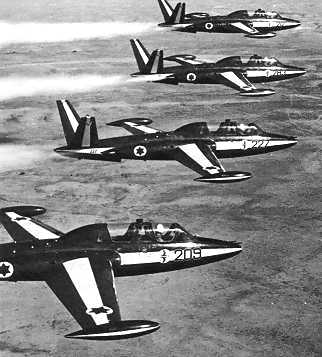IAF Aircraft Inventory: Fouga CM.170 Magister (Zukit)
 |
The first jet-engined training aircraft in the world, the French Fouga Magister first took to the air on July 23rd, 1952. It has since seen service with numerous air forces, among them the Irish, Brazilian and, of course, the French which has also adapted the type for operations off aircraft carriers.
The Israeli Air Force operated over 80 examples of the Magister, 7 of which were lost in action. The first Fouga arrived in Israel in 1957 and shortly later "Bedek Aviation" begun assembling the aircraft locally, changing the company name to Israel Aircraft Industries. The First two aircraft were completed in 1959 and the IAF received its first aircraft, no. 15, on July 7th 1960. The Fougas entered service with the IAF's flight school where they were used for both basic and advanced jet training. With their arrival the aircraft also formed the IAF's aerobatic team which to this day flies the type and is manned by flight school instructors.
Despite having the most rudimentary of armaments, in 1964 the flight school Fougas were nonetheless organized into a fighting squadron, to act as a fighting force in case of hostilities. The Fougas got to prove their combat effectiveness shortly later. On the eve of the 1967 Six-Days war, 44 Flight School Magisters were allocated to actively take part in the fighting, manned by school instructors as well as IAF long time reservists and even cadets on their advanced training. Before the outbreak of hostilities on June 5th, the aircraft were fitted to carry air to ground ammunition and the pilots begun their weapons delievery and ejection (the type has no ejection seat) training.
The Fougas with their cannons and light rockets and bombs were not designed for dealing with anti aircraft defences. On the outbreak of the war, however, the need arose for close combat air support for Israeli ground forces, and the Fougas had to play the part as none of the IAF's major fighting aircraft, such as the Mirage IIIC and Vautour, were available, being in the midst of operation "Moked". Even after such aircraft were available, later in the war, the Fougas continued to participate in the fighting, providing much needed support.
On the morning of June 5th flight school Fougas went out on their usual training flights, ment to fool Egyptian intelligence into thinking operations were as routine as ever. At the same time however, other Fougas were already on their way to their first operational missions of the war, attacking Egyptian positions in the Sinai, assisting Israel's armoured divisions in their push into the peninsula. Four pilots were killed during the first sorties into the Sinai, all from hits by anti aircraft fire. The type's major contribution to the war effort came on the second day of the fighting, June 6th, on the Jordanian front. When the IDF begun the conquest of Jerusalem, the Fougas were instrumental in holding back Jordanian armour which was heading towards the city, destroying over 50 tanks and over 70 other armoured vehicles. For the remainder of the war the Fougas participated in attacks on the all fronts, attacking Jordanian and Iraqi positions in the West Bank as well as Syrian posts on the Golan Heights. By the end of the war 6 pilots had been killed in action, 7 aircraft were lost, while Two Fouga pilots received commendations for their performance during the fighting. The type returned to its origianl role in the IAF's flight school, and was finally stripped of all its armament by the end of the 1960s. in 1974 the Magisters were replaced by A-4 Skyhawks in the advanced jet training role, keeping their basic training role alone.
By the beginning of the 1980s, the IAF's Fouga Magisters were beginning to show structural fatigue, cracks appearing in the wings and fuselage. In order to prolong the type's service with the IAF, a plan was devised at Israel Aircraft Industries to upgrade and refurbish the aircraft, thereby extending their service life. Two Magisters were handed over to IAI and in Septermber 1980 the upgraded aircraft, the Zukit, took off on its maiden flight. The new aircraft had undergone over 250 modifications, including the refurbishment of new engines and a newly designed cockpit. Serial production begun in 1983 and the last aircraft was handed over to the IAF's flight school in 1986, most of the Fougas having been upgraded to Zukit standard. The Zukit continues the role of the Magister in basic jet training, a role it will play long into the 21st century. The IAF has been looking for an aircraft to replace the Zukit for a number of years but has failed to find one, mainly because of monetary constraints.
Specification: Israel Aircraft Industries Zukit
Type: Tandem two-seat basic and advanced trainer.
Powerplant: 2 * Turbomeca Marbore 6.
Performance: cruising speed - 354 knots, max speed - 378 knots, rate of climb - 3540 ft/minute, service ceiling - 44300 ft, max range - 1250km.
Weights: empty - 2550kg, max takeoff - 3100kg.
Dimensions: span - 12.20m, length - 10.06m, height - 2.80m.
Armament: 2 * 7.62mm guns at nose, light rockets and bombs on underwing weapon stations.
Sources: IAF Inventory


